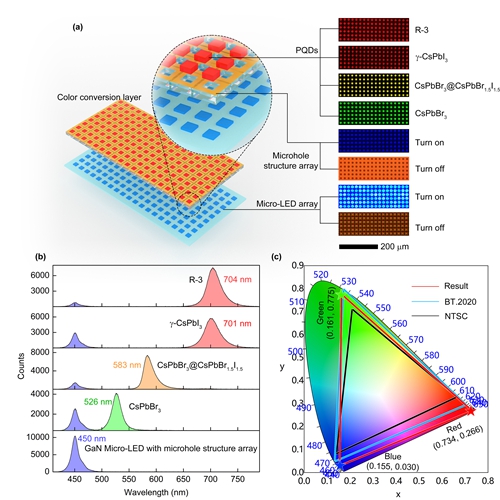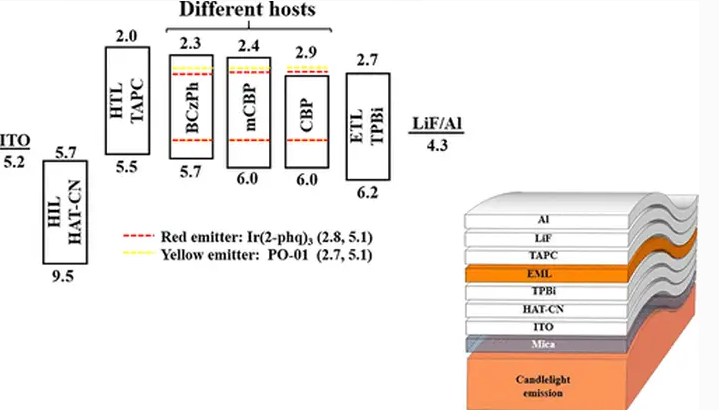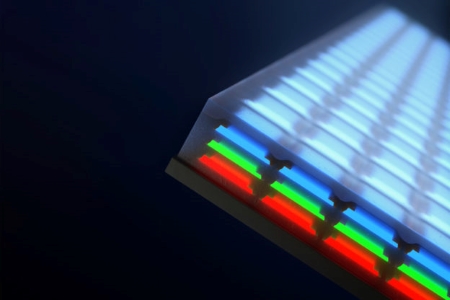Recently, the laboratory of Xiamen University has made a breakthrough in Micro LED full-color display technology. This achievement was published on Advanced Materials under the title of "Brightened bicomponent perovskite nanocomposite based on Frster resonance energy transfer for Micro LED displays".
Micro LED is the most suitable solution for future display technology, and its full-color technology is a recognized difficulty in international academic and industrial circles in recent years. Due to its many advantages in luminescence performance, perovskite quantum dots have extremely high application potential in the field of Micro LED full-color display. However, the shortcomings of perovskite quantum dots are also obvious, especially the red light-emitting perovskite quantum dots, which have worse stability and weaker brightness than green light-emitting perovskite quantum dots. Therefore, exploring new quantum dot color conversion technology is of great significance and value for solving the current technical problems of Micro LED full-color display and enhancing my country's international competitiveness in the Micro LED display industry.

Aiming at the current difficulties, Semiconductor Lighting Laboratory proposed a new strategy. Green perovskite quantum dots (CsPbBr3) were coated with red luminescent perovskite quantum dots (γ-CsPbI3). A core-shell structure is formed, and the conditions for energy transfer are satisfied between the two quantum dots. γ-CsPbI3 completely absorbs the luminescence of CsPbBr3. Since CsPbBr3 transfers energy to γ-CsPbI3, γ-CsPbI3 will exhibit the excitation characteristics of CsPbBr3, and the optimal excitation wavelength of this structure can be adjusted. In this work, the optimal excitation wavelength of red-emitting two-component perovskite quantum dots was gradually adjusted to the blue light region. Under blue light excitation, the photoluminescence intensity can be increased by more than 3 times, and the quantum yield of blue light excitation is close to 100%. , stability has also been significantly improved.
After adjusting the optimal excitation wavelength of the red quantum dots to the blue region, the researchers applied the two-component quantum dots to the color conversion layer of the blue Micro LED. With the help of the glass microwell array as a carrier, the deposited quantum dot array corresponds to the Micro LED array, achieving excellent color conversion performance, and the display color gamut can reach the NTSC standard of 135.9%. This research combines the non-radiative energy transfer mechanism with Micro LED color conversion technology, "two-pronged approach" in terms of performance improvement and process simplification, breaking through the current bottleneck of Micro LED red light color conversion technology, and realizing high-quality Micro LED at a lower cost The full-color display effect helps solve industrial technical problems and promotes the industrialization of my country's Micro LED full-color display technology.
Scientists invent flexible organic LED with fewer blue wavelengths than candlelight
In a paper recently published in ACS Applied Electronic Materials, the researchers created a flexible organic LED that emits a candle-like light for more comfortable use at night. Project investigator Jwo-Huei Jou and other researchers developed organic LEDs that emit warm white light, similar to that produced by candles. However, these devices still emit some blue wavelengths, which may interfere with sleep because it reduces the body's production of melatonin.
These devices are made of rigid materials and are not bendable. One option to make them flexible is to use a plastic substrate, as is done with other organic LEDs. But plastic doesn't hold up to repeated bending very well. Another option is mica -- a naturally occurring mineral with extreme temperature tolerance that can be split into bendable, transparent sheets. So Jou, Ying-Hao Chu, and colleagues wanted to develop a better organic LED and apply it to a mica backplane to create a bendable, candle-like light with a long lifespan.
The researchers deposited a transparent thin film of indium tin oxide on a transparent mica sheet as the anode of the LED, which can be bent 50,000 times without breaking. Next, the team mixed the light-emitting substance N,N'-dicarbazole-1,1'-biphenyl with red and yellow phosphorescent dyes to create a light-emitting layer. This layer is then placed between a conductive solution with an anode on one side and an aluminum layer on the other, creating a flexible organic LED.
When a constant electric current was applied to the device, it produced bright, warm light with even less blue wavelength emission than natural candlelight. Calculations show that 1.5 hours of exposure to LEDs will suppress a person's melatonin secretion by about 1.6%, while light from a cool-white compact fluorescent light will suppress melatonin secretion by 29%. The flexibility of their candle-like organic LEDs opens up opportunities for the design of blue-light-free nighttime devices, the researchers say.

Researchers develop world's smallest silicon-based LED
Researchers have created the world's smallest silicon LED and a holographic microscope, taking smartphone applications to the next level, and cameras turning into portable, high-resolution microscopes. While photonic chips have made progress in lighting, it has been difficult to integrate a small, bright on-chip light emitter. Therefore, manufacturers generally use off-chip light sources, but this light source has low energy efficiency and limits the scalability of photonic chips.
Now SMART researchers have developed the world's smallest silicon LED, less than 1 micron wide, with an intensity comparable to larger silicon LEDs, making off-chip emitters likely a thing of the past. The researchers placed their mini-silicon LEDs in 55-nanometer CMOS on a single chip along with other optoelectronic components. To test how the LED could work in the real world, they placed it in a lensless holographic microscope, which is smaller and less expensive than a normal microscope. The researchers used a light source to illuminate the sample, allowing the light to scatter onto a CMOS digital image sensor to form a digital hologram, which was then processed by a computer to generate the image.

However, reconstructing images with this type of microscope can be difficult because knowledge of the aperture of the light source, its wavelength, and the distance from the sample to the sensor is required. To do this, the researchers used a neural network algorithm to reconstruct objects observed with a holographic microscope. The researchers found that the holographic lens provided more accurate high-resolution images than ordinary optical microscopes, with a resolution of about 20 microns, smaller than human skin cells (20 to 40 microns in diameter) and white blood cells (30 microns).
The researchers believe that these studies may help to reconstruct microscopic objects, such as human tissue samples and plant seeds, and can also be used in existing smartphone lenses. Simply modify the phone's silicone chip and software to convert the phone into high-resolution rate microscope.
Post time: May-12-2023
